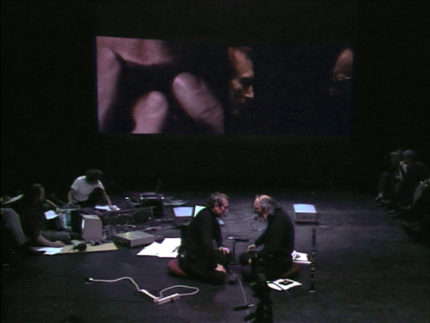Two Ways at Once (Deux sens à la fois), 1998
Gary Hill, George Quasha, and Charles Stein
Intermedia performance for two projectors, laserdisc player with remote control, digital video camcorder, video mixer, three headphone microphones, clarinet, surround sound audio system, serge modular components, laptop computer, and prepared texts
Occasioned by Gary Hill’s show at the Musée d’art contemporain de Montréal, the performance involved both video projections on the walls of the auditorium (as two-projector double screen) and live text- and sound-generation. The audience sat on three sides of the auditorium, with the double screen occupying the fourth. George Quasha and Charles Stein were stationed in the center of the room and performed improvisations from written material as well as instrumental (clarinet) and vocal sound. Concurrently, Gary Hill layered these elements with audio processing and vocal intervention (using Serge Modular components) and improvisations with video source material from his installation works. This was projected on one of the screens and involved mixing, variable speed, and directional playback. On the other screen he alternated images from a live camera focused on vocal and instrumental sound performances by Charles Stein and George Quasha and bilingual “axial” texts (i.e., structurally “double-valenced”/syntactically open) generated by George Quasha on a laptop computer. Some texts were prepared in advance, while others were created on the spot in interaction with Gary Hill’s video and with audience response.
Performance themes include transformations of the concepts of “twoness” or “twinness” and the idea of a “line” that divides, distinguishes, and creates the physical or conceptual spaces it is drawn in. The title, itself a bilingual axial poem by George Quasha, invokes semantic twinning as bi-directional thinking (“two ways at once” in French plays on “sens” as both “sense” and “direction”). Similarly this notion of division or twoness, related conceptually to the circumstance of the performance, was continuously played upon by the performers; for instance, the performance played with the bi-lingual reality of Montreal and the audience itself (and the sensitive political connection/split between French and English Canada) and the joint or crack between the two languages. But it also worked with a series of boundaries that appeared and vanished within the piece—boundaries between text and image, live and recorded material, improvised and textual material, audience and performer, performer and performer, and performance time and “real” time. The performance ended by flowing into an extended and lively public conversation between the audience and the performers.
Quasha, George and Charles Stein. An Art of Limina: Gary Hill’s Works and Writings. Barcelona: Ediciones Polígrafa, 2009, p. 596.
Musée d’art contemporain de Montreal, Quebec, Canada, January 30, 1998.
La Chance, Michaël. “Vidéognose,” Spirale, Montreal (May – June 1998), p. 13.
Quasha, George and Charles Stein. La performance elle-même in Gary Hill: Around & About: A Performative View. Paris: Éditions du Regard, 2001, pp. 78, 79 – 80, 99, 102, 105, 108 – 109.
Gary Hill: Selected Works and catalogue raisonné. Wolfsburg: Kunstmuseum Wolfsburg, 2002, GHCR 107, p. 216.
Quasha, George and Charles Stein. An Art of Limina: Gary Hill’s Works and Writings. Barcelona: Ediciones Polígrafa, 2009, pp. 37, 493, 494, 496, 596, 614.





